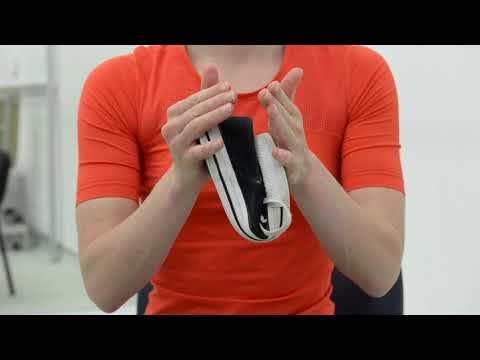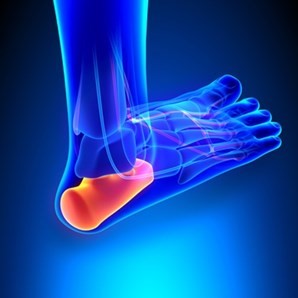
What is Plantar Fasciitis?
Plantar Fasciitis, also known as heel pain, is one of the most common conditions affecting the foot. Your plantar fascia is a strong band of tissue that stretches from your heel to your toes. It supports the arch of your foot and also acts as a shock-absorber in your foot when you walk.
Plantar Fasciitis often occurs in people between the ages of 40-60, however can affect any age. The condition is usually diagnosed by clinical findings alone. Classic signs and symptoms of Plantar Fasciitis are:
- A gradual onset of pain affecting the base of the heel
- Pain during the first steps out of bed in the morning
- Pain after a period of inactivity or rest
- Lessening pain with moderate foot activity
- Worsening pain later on during the day or after long periods of standing or walking
What Causes Plantar Fasciitis?
There is usually a combination of factors that can lead to the development of Plantar Fasciitis such as:
- Wearing unsupportive footwear
- Tight or weak muscles around the foot and ankle
- Being overweight
- Occupations that involve extended periods of standing or walking on hard surfaces
- Sudden increase in physical activity levels - for example, recently started running
What Can I Do for my Plantar Fasciitis?
Changes in lifestyle and modifying the known causes as previously mentioned can reduce the symptoms getting worse. The one professional who can help you manage your symptoms is you!
Footwear –
Avoid wearing flat unsupportive shoes.
Shoes that have flexible soles generally offer the foot less support and can place strain on tissues such as your plantar fascia. If you have shoelaces makes sure they are tied appropriately.
Strengthening and stretching exercises –
Targeted strengthening and stretching exercises for the muscle in and around your foot and ankle can help to improve your heel pain.
Local NHS Ayrshire & Arran podiatrists have devised exercise clips to help with your symptoms. Please click HERE to access these videos.
Before undertaking the suggested exercises please review our disclaimer. Please click HERE
Painkillers-
A range of different medications may be available to help reduce your pain to allow you to move more comfortably. Do not exceed the daily allowance of these medicines even if your pain is high and always consult a health professional prior to taking any new medication. If you are unsure of what medication you can take, speak with your local pharmacist, practice nurse or GP for guidance.
It is important that if you are prescribed medication that you take them regularly and at the recommended dose (see medication packet for details). All medicines can cause side-effects, particularly if they are not used as prescribed. Side-effects range from common to uncommon and vary from person to person. Information on possible side-effects are available on the leaflet inside the packaging of your medication. It is important to speak to your local pharmacist, practice nurse or GP who may be able to change the dose or the medication itself to something that is more suitable.
You should try and use the prescribed medication regularly at the recommend dose as prescribed. Some medicines can take a number of weeks to have significant effect, however this is dependent on the person. It is best to speak again with your GP or pharmacist about what other options are available if you don’t feel your medicines are helping.
Weight management –
Additional weight can place extra strain on the joints and tissues in your feet. Losing even a small amount of weight can make a big difference to the strain on your joints when walking, running, or going up and downstairs.
If you need help with weight-control, go to our Self Management External Sources to access our weight management pages where you can find information, advice and groups you can join to help you manage your weight better. Follow this link to an NHS BMI Calculator to guide you on whether you should consider weight management
Modifying activity levels -
If you are in pain don’t tackle all your activities of daily living, such as housework, at once. Break the harder jobs down into smaller time frames and do something gentler in between. Extensive walking or standing should be avoided if it aggravates your heel pain. It is recommended to modify activities rather than to fully stop all forms of movement or exercise so try swimming or cycling instead of walking or running.
Plantar Fasciitis Exercises
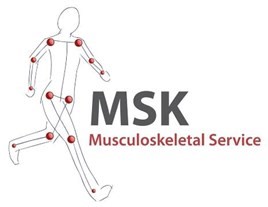
The exercises in the videos below have been provided to help with your heel pain. If there is any doubt about your fitness to do these exercises then please discuss this with your GP.
You may find that these exercises may slightly increase your symptoms initially. However you should find that the exercises themselves will become easier to do. These exercises can take up around 12 weeks for you to notice a great improvement.
If the exercises do cause some discomfort then taking prescribed medication from your GP or pharmacist may help you to continue to exercise.
If these exercises cause a large increase in your pain or after 12 weeks there are no noticeable changes in your day to day symptoms then please contact your GP or NHS Inform for more advice.
The guide below will help ensure you are working at the right level:
Pain during exercise
Aim to stay in the green or amber boxes. If you are in the red area then you can modify the exercises by trying reducing the amount of movement during an exercise, the number of repetition, reducing the weights, reducing your speed or increasing rest time between sets.

Pain After Exercise
Your pain or other symptoms should return to your pre exercise baseline within 30 minutes of exercising. You should not feel an increase in pain or stiffness that last longer than 60minutes the next morning after your exercises.
Before undertaking the suggested exercises please review our disclaimer. Please click HERE
Exercise 1 : Plantar Fascia Towel stretch
Plantar Fascia Towel stretch – YouTube
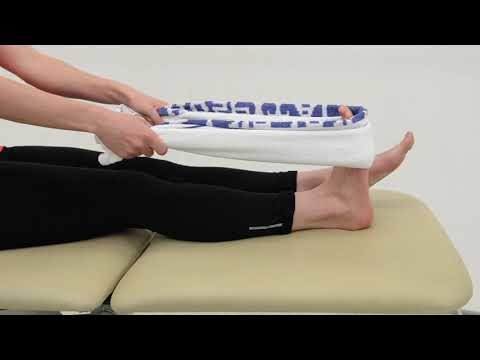
This exercise is aimed at stretching the plantar fascia. To begin place a towel around the ball of the affected foot, keep your heel in contact with the ground and avoid bending your knee. Pull the towel toward you until you feel the stretch in the bottom of your foot and back of your calf muscle. Hold the stretch for 20 seconds and repeat 3 times with a small rest period between stretches.
It is particularly useful to perform the stretch first thing in the morning or after a period of rest.
If you feel this stretching exercise is making your condition worse the please focus on performing the exercises which are marked as strengthening
Exercise 2: Plantar Fascia Wall Stretch
Plantar Fascia Wall Stretch – YouTube
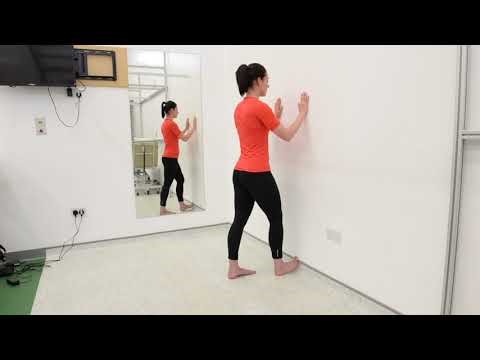
This exercise is aimed at stretching the plantar fascia as well as the calf muscle. Place your hands on a wall for support then wedge the toes of the affected foot against the wall with the foot angled at around 45 degrees. Keep the heel of the affected foot against the ground at all times. Now begin to bend the front knee whilst moving your body towards the wall until you feel a stretch in the back of your calf and bottom of your foot. Hold the stretch for 20 seconds and repeat 3 times with a small rest period between stretches. This stretch can be done with or without shoes on.
If you feel this stretching exercise is making your condition worse the please focus on performing the exercises which are marked as strengthening
Exercise 3: Standing Calf Stretch (Gastrocnemius and Soleus muscles)
Plantar Fascia Standing Calf Stretch (gastrocnemius and soleus muscles) – YouTube
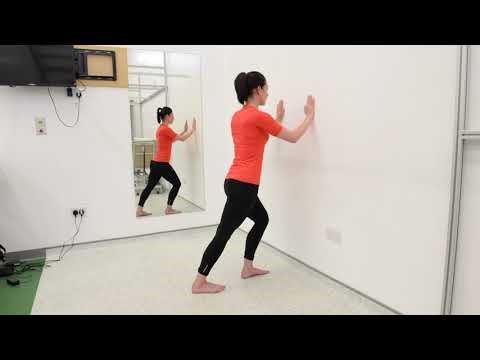
(Part 1) Place you hands on a wall for support and take a step back with the affected foot. It is important that the heel of the affected foot remains on the ground throughout this stretch, additionally try to keep the toes of both feet pointing straight towards the wall rather than rotating the foot so that the toes are pointing outwards. Now begin to bend the knee of your front leg whilst moving your chest towards the wall until you feel a stretch in the back of you calf muscle, hold for 20 seconds and repeat 3 times with a small rest period between stretches.
(Part 2)
The second part of this exercise is aimed at stretching the soleus muscle. Adopt the same starting position as you did for the previous exercise. Slide the affected foot towards the front foot as demonstrated. This time when bending the front knee also bend the knee of the back leg until you feel a stretch deeper in the calf muscle. Hold this for 20 seconds and repeat 3 times. As before be sure to keep your heels in ground contact throughout the stretch.
If you feel this stretching exercise is making your condition worse the please focus on performing the exercises which are marked as strengthening
Exercise 4: Standing Heel Raises
Plantar Fascia Standing Heel Raises – YouTube
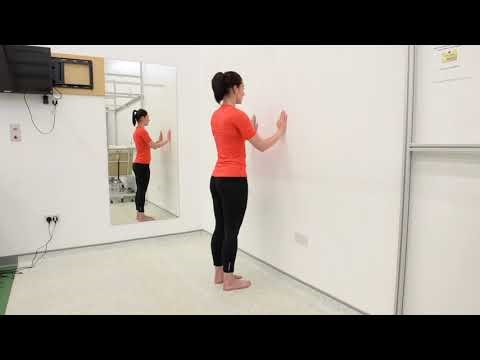
This exercise is aimed at strengthening the muscle in your calf and foot. To perform this exercise stand close to a wall, placing your hands against the wall for balance. Raise up slowly onto your tip toes lifting both heels off the ground, when you have raised the heels up up as far as you are comfortable with begin to slowly lower the heels back down to the ground. Strengthening exercises should be built up gradually over a period of weeks, so to begin with do as many repetitions as you can manage.
The aim is to do 3 sets of around 10 -15 repetitions but remember it may take you several weeks before you are able to reach close to this target.
Exercise 5: Plantar Fascia Loading Exercise (High Load Exercise)
Plantar Fascia Loading Exercise (High Load Exercise) – YouTube
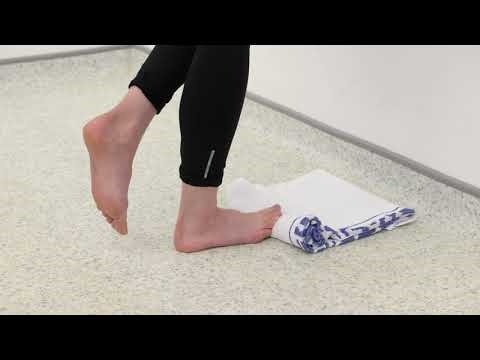
This exercise is aimed at strengthening the muscles in the foot. Place a folded up towel on the floor as is seen in the video. Place the toes of the affected foot against the folded edge of the towel in a flexed position. Try to have your toes flexed up as far as you can comfortably manage. Now begin to raise up onto your tip toes lifting your heel off the ground. Try to raise up onto the tip toes for a count of around 3 seconds, pause at the top for 2 seconds then slowly lower the heel back down to the ground for a count of 3 seconds.
Perform this exercise every second day.
Strengthening exercises should be built up gradually over a period of weeks, so to begin with do as many repetitions as you can manage. The aim is to do 3 sets of around 12 repetitions but remember it make take you several weeks before you are able to reach close to this target.
Exercise 6: Intrinsic Towel Strengthening Exercise
Plantar Fascia Intrinsic Towel Strengthening Exercise – YouTube
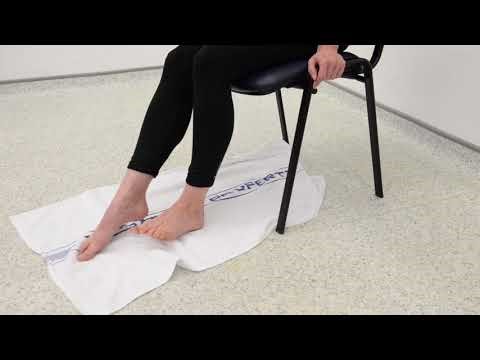
This exercises is aimed at strengthening the small intrinsic muscles in the foot. Place a small towel flat on the ground. This exercises is performed in a seated position make sure your back is straight and leg bent comfortably at 90 degrees with your affected foot placed flat on the towel. Use your toes to begin crunching the towel up with the aim of pulling the towel in towards you, do this in a slow controlled manner. When you have pulled the towel in as far as possible straighten it back out again and repeat the process between 3-5 times. Make sure your heel stays in ground contact throughout the exercise.
Exercise 7: Intrinsic Theraband Strengthening Exercise
Plantar Fascia Intrinsic Theraband Strengthening Exercise – YouTube
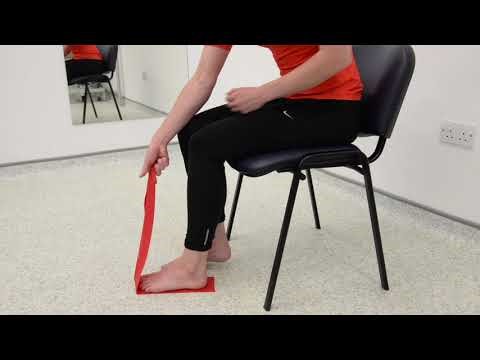
This exercise is aimed at strengthening the small intrinsic muscle in the foot. This exercises is performed in a seated position make sure your back is straight and leg bent comfortably at 90 degrees with your affected foot placed flat on a strip of thera-band. Pull the end of the band over your knee towards you which in turn will pull your toes up into a flexed position. Anchor the band on your thigh maintaining a good level of tension on the band throughout the exercise. Hold the band tight and begin to slowly push your toes down towards the ground against the resistance of the band, when your toes reach the ground allow them to slowly raise back up to their starting position.
Aim to do 3 sets of around 20 repetitions. You can adjust the difficulty of the exercise by creating more or less tension on the band. Make sure your heel stays in ground contact throughout the exercise.
Exercise 8:- Cold therapy
Plantar Fascia Cold Therapy – YouTube
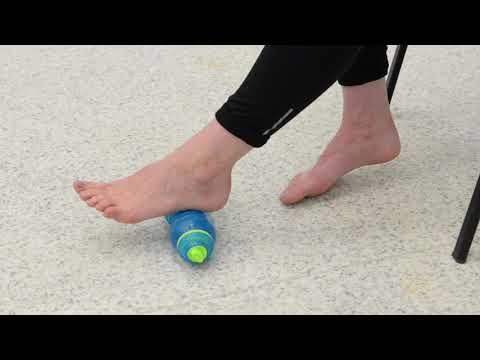
This exercise is an effective way of massaging your plantar fascia. Fill a small bottle with water until it is around ¾ of the way full and place in the freezer until the water is frozen. Place the bottle of water on the ground then place your affected foot on top of the bottle. Begin slowly rolling your foot over the bottle from your heel to your toes and back again. Apply as much pressure as you are comfortable with and continue rolling back and forth for around 5 minutes.
Advice Video: Footwear advice
Footwear Advice – YouTube
